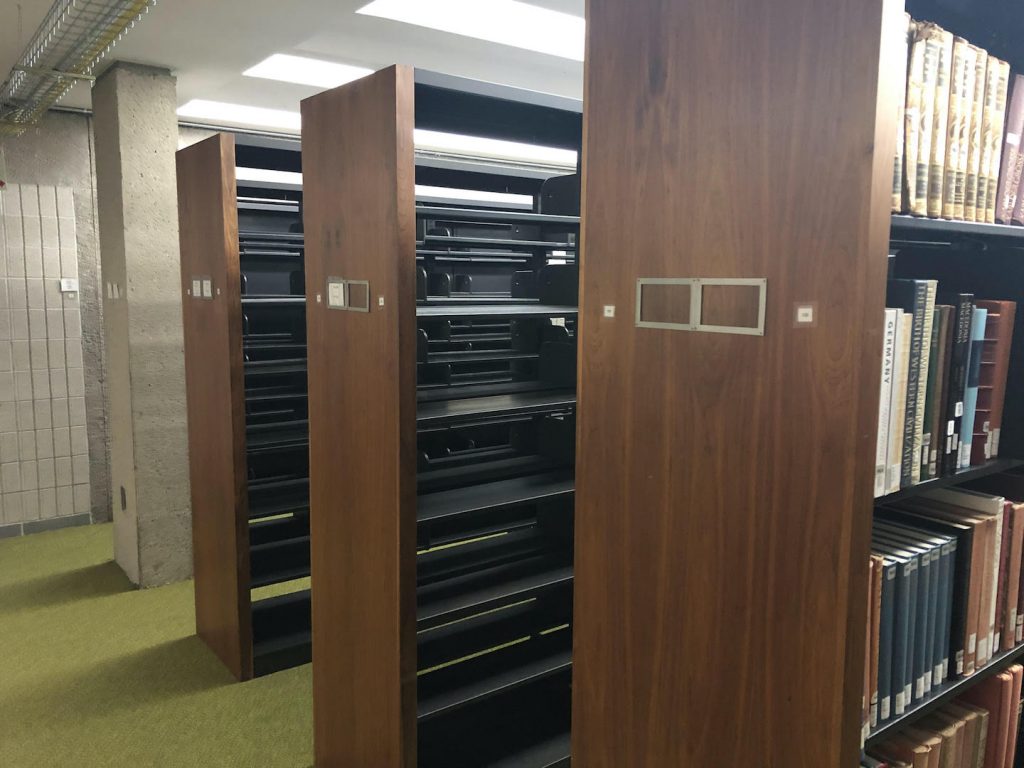Many Hands Make Libraries Work, Part 2
Last fall, my colleague Cody Mansley wrote an article about the broad collaboration he led to reorganize a fifth of the Theology & Ministry Library’s collection, entitled Many Hands Make Libraries Work. In the same spirit of appreciation and collaboration, I am pleased to report on another large project recently completed at the TML. The BC Libraries received a gift of over 9000 books on Islamic Theology- the personal library of incoming faculty member Gerhard Bowering. These items, mostly in Arabic, greatly expand the BC holdings on this topic. It is truly a unique and valuable collection! Creating the shelf-space for such a large gift proved to be a challenging task at the TML.

We had to create enough space to house roughly 9000 items as well as provide enough space for them to eventually be catalogued; in all, we needed to create about 15,000 inches (1250 feet, or nearly ¼ mile) of shelf space. In order to make this space, we would need to send approximately 10,000 items offsite, and then condense and shift the remaining books.
Steve Dalton, the Head Librarian at the TML, determined that the best candidates for newly-offsite items would come from our C-Z material. Since we are a Theology library, the majority of our circulating collection lives in B through BZ, and Steve rightly suspected we would find more than enough items that had never circulated which could be sent offsite. Scott Britton, Associate University Librarian for Public Services, liaised with Arms Wakefield to secure a storage footprint and sufficient boxes to accommodate the items to be sent offsite. We were given a deadline of April 30, 2021 to be ready to receive the donation, and Steve asked me to coordinate the project on the ground at the TML.
The first person I consulted was Michael McGrath, my colleague in Access Services. Michael’s proficiency with technology far exceeds my own; he created a report and a matching Excel spreadsheet including all the items which met our criteria as offsite-candidates. Michael also offered his expertise in project management and helped me develop a preliminary workflow for the student labor involved in identifying, pulling, and boxing each individual item. As the tech-czar of the TML, Michael also secured the laptops and scanners needed to complete the tasks of locating, scanning, and boxing each item.

Amy Brown, Head of Special Collections Technical Services, and Kathryn Doan, Senior Metadata & Systems Librarian, helped to further refine Michael’s report and explained the workflows involved in sending items offsite. We were able to pare down the list to only include the items that were least likely to produce errors during the process of moving offsite. Kathryn also offered her services for a later stage in the project: batch editing each list of items so that they would appear in their new location in our library system.
Paul Bridden, Manager of Circulation and Collection Maintenance Services, was instrumental in getting this project underway and assisted throughout. He met with me remotely to review the spreadsheet created by Michael and edited by Amy and Kathryn, and then created a specialized version of that spreadsheet to be used by students during the process of finding each item. Paul also created a spreadsheet template to be used in packing each individual box set off site, and then compressed batches of these files so that Kathryn could batch edit the items contained in them. He also came over to the TML in person to walk through our student workflow and helped refine that process. His planning and consistent help throughout the process was crucial to its success.
Once we had the list of items, the boxes, and a workflow established, we could begin the painstaking work of going through the spreadsheet, locating an item, validating that it did in fact fit the criteria, and then packing it into a box. This work was done almost entirely by our student staff at the TML. I cannot stress how detail-oriented this work was or how much of this project’s success is due to their tireless work. In order to meet our deadline we had to have a student working on validating and packing almost every hour that we were open; students even had to assemble and barcode the boxes themselves, and then stack them in the TML’s atrium to await pickup.
Leea Stroia, the Supervisor at the TML, generously allowed other projects to pause so that I had sufficient student workers for this project and time to train them. The success of this project owes quite a bit to her flexibility and patience. As for the student workers, there were fewer than fifteen errors out of the nearly ten thousand items scanned: truly exemplary work! Each error was caught and rectified due to Kathryn’s tireless quality control. The validating and boxing of all items (400 boxes holding 9421 items in total) was completed on March 31.
However, the project still required a precise and efficient shift, which was executed flawlessly by Michael McGrath. Aided once again by our student staff, Michael was able to save weeks of time by doing much of the shifting in tandem with the boxing process. When the shifting completed on April 12, we had gained 483 shelves for a total of 16,653 inches (1388 feet, or just over ¼ mile) over two weeks ahead of our deadline.

For me, this project exemplifies the best of what it means to work in the BC libraries. From start to finish it was an exercise in collaboration between at least three different departments